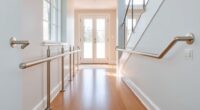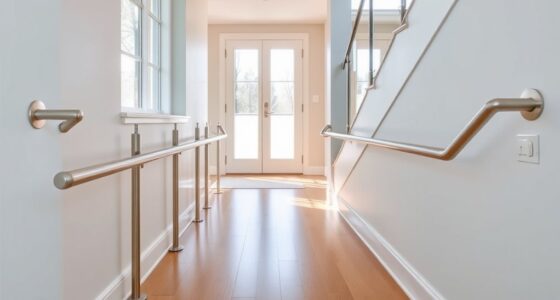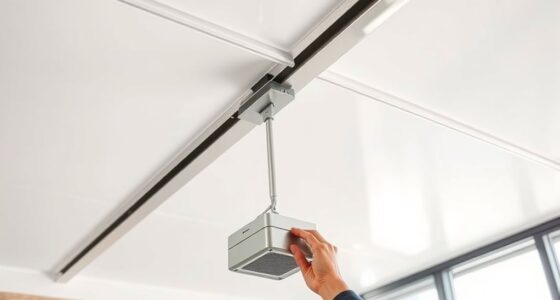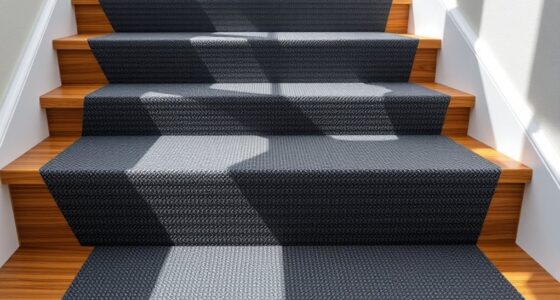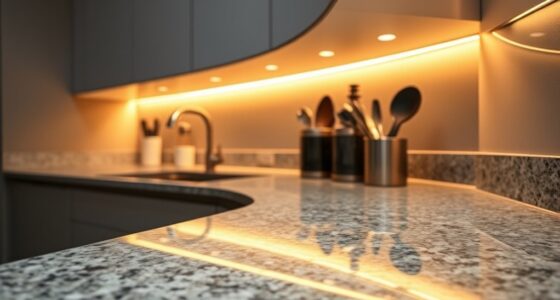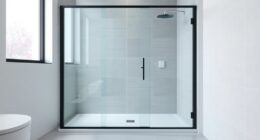To convert a spare room into a main-level bedroom, you should prioritize privacy by soundproofing and installing a sturdy door, while upgrading windows and adding thick curtains helps control noise and light. Consider plumbing modifications if needed for a nearby bathroom or sink, and verify all work complies with local building codes and permits. Proper ventilation and heating also make the space comfortable year-round. Keep exploring for detailed steps to make your project successful.
Key Takeaways
- Ensure proper privacy with soundproofing, sturdy doors, and thick curtains to create a comfortable bedroom environment.
- Plan plumbing modifications carefully if adding an en-suite or connecting to existing lines, and obtain necessary permits.
- Incorporate adequate ventilation and heating solutions like exhaust fans and radiators for year-round comfort.
- Verify local building codes and secure permits for structural, plumbing, and electrical changes before starting renovation.
- Design the space to optimize layout, privacy, and functionality, working with professionals for technical tasks.
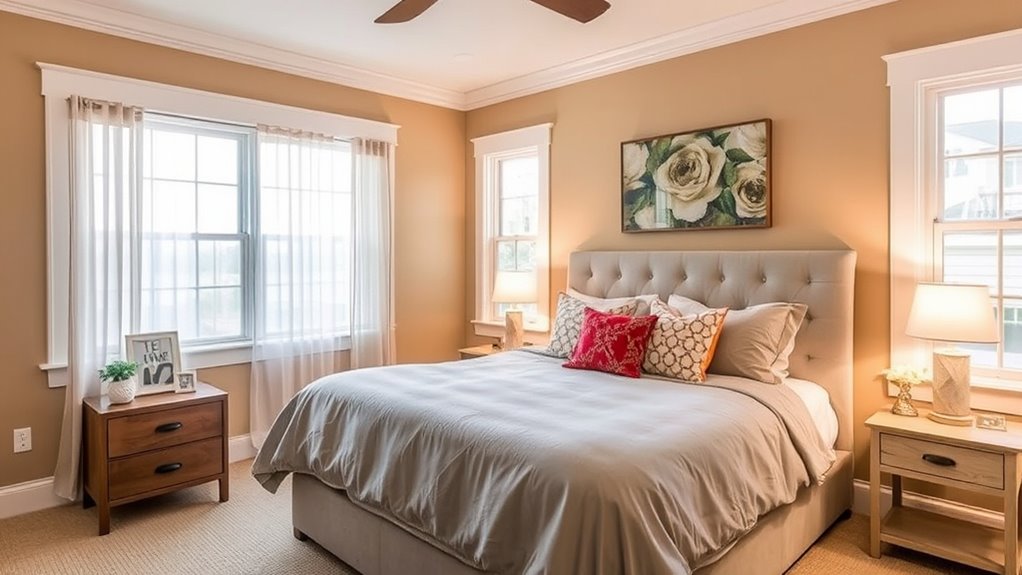
Transforming a spare room into a main-level bedroom can considerably enhance your home’s comfort and functionality. It creates a private retreat for family members or guests and can even boost your property’s value. However, before diving into the project, you need to consider some key factors. Privacy concerns are paramount, especially if the room was previously used for purposes that didn’t require much seclusion. You’ll want to ensure the space feels like a true bedroom—adding soundproofing, installing a sturdy door, and possibly upgrading windows to reduce noise infiltration are essential steps. These adjustments help create a cozy, private environment where occupants won’t feel exposed or distracted by outside noise or activity.
Another important aspect is addressing plumbing modifications. If the room isn’t already connected to a bathroom or doesn’t have easy access to existing plumbing, you’ll need to plan for how to incorporate these features. Adding a bathroom or ensuring there’s a nearby water supply involves careful planning. You might need to reroute plumbing lines or install new fixtures, which can be complex but is often worth the effort. This not only increases convenience but also adds significant value to your home. Keep in mind that plumbing modifications usually require permits and professional assistance to ensure everything complies with local building codes and functions properly.
As you plan the transformation, think about how these plumbing and privacy considerations integrate into your overall design. For privacy, consider installing thick curtains or soundproof drywall to block noise and light. For plumbing, decide whether you’ll connect to existing lines or need to extend them. If extending plumbing lines, work with licensed plumbers who can handle the technical aspects safely and efficiently. You’ll also want to select appropriate fixtures, such as a compact bathroom setup or a simple sink and toilet, that fit within your space and budget. Additionally, understanding local building codes and permits is crucial to ensure your modifications meet safety and legal standards.
Finally, don’t forget about ventilation and heating. Proper airflow and temperature control help make the room comfortable year-round. Installing exhaust fans, ensuring good insulation, and integrating heating options like radiators or ductless heat pumps can make your new bedroom inviting. By carefully addressing privacy concerns and plumbing modifications, you turn your spare room into a functional, private, and comfortable main-level bedroom that meets your needs and enhances your home’s overall value.
Frequently Asked Questions
What Permits Are Needed for This Conversion?
You’ll need to check your local building codes to determine which permits are required for converting your spare room into a main-level bedroom. Typically, you’ll need an electrical permit for any wiring updates or new outlets. Make sure to verify if a building permit is necessary for structural changes or adding an egress window. Contact your city’s building department to ensure you comply with all regulations and obtain the right permits before starting your project.
How Much Does It Typically Cost?
You can expect the cost to convert a spare room into a main-level bedroom to typically range from $5,000 to $15,000, depending on your project’s scope. To stay on track, do a thorough cost estimation and budget planning, considering expenses like permits, electrical work, insulation, drywall, flooring, and finishing touches. Getting multiple quotes from contractors will help you manage costs and avoid surprises.
Can I Do This Conversion Myself?
You can definitely tackle this yourself, just like assembling a complex puzzle. Start with DIY tips like updating electrical wiring and insulating walls, and explore design ideas to make the space cozy and functional. Remember, thorough planning and patience are key. You might find it rewarding to learn new skills—many homeowners have turned spare rooms into inviting bedrooms with some research and effort.
How Long Does the Process Usually Take?
The renovation timeline for converting a spare room into a main-level bedroom typically takes about 4 to 8 weeks, depending on complexity. Your choice of contractor impacts this schedule—experienced professionals usually work faster and more efficiently. You should plan for permits, design, construction, and finishing touches. Regular communication with your contractor helps keep the project on track, ensuring you get your new bedroom ready as smoothly and quickly as possible.
Are There Any Zoning Restrictions to Consider?
Think of zoning restrictions like a map guiding your journey—without it, you might end up lost. You’ll need to check local zoning laws and permit requirements, which vary by area. For example, some neighborhoods limit bedroom conversions to preserve character or density. Contact your city or county zoning office early to avoid surprises, ensuring your project complies with all restrictions and avoids costly delays.
Conclusion
Transforming your spare room into a main-level bedroom turns an empty space into a cozy retreat, where sunlight dances across fresh paint and plush new carpeting. As you step inside, imagine the soft glow of evening lamps casting gentle shadows, inviting restful nights and peaceful mornings. With each detail in place, your home becomes a sanctuary—a warm embrace that welcomes you home, turning an ordinary room into a cherished haven of comfort and tranquility.

